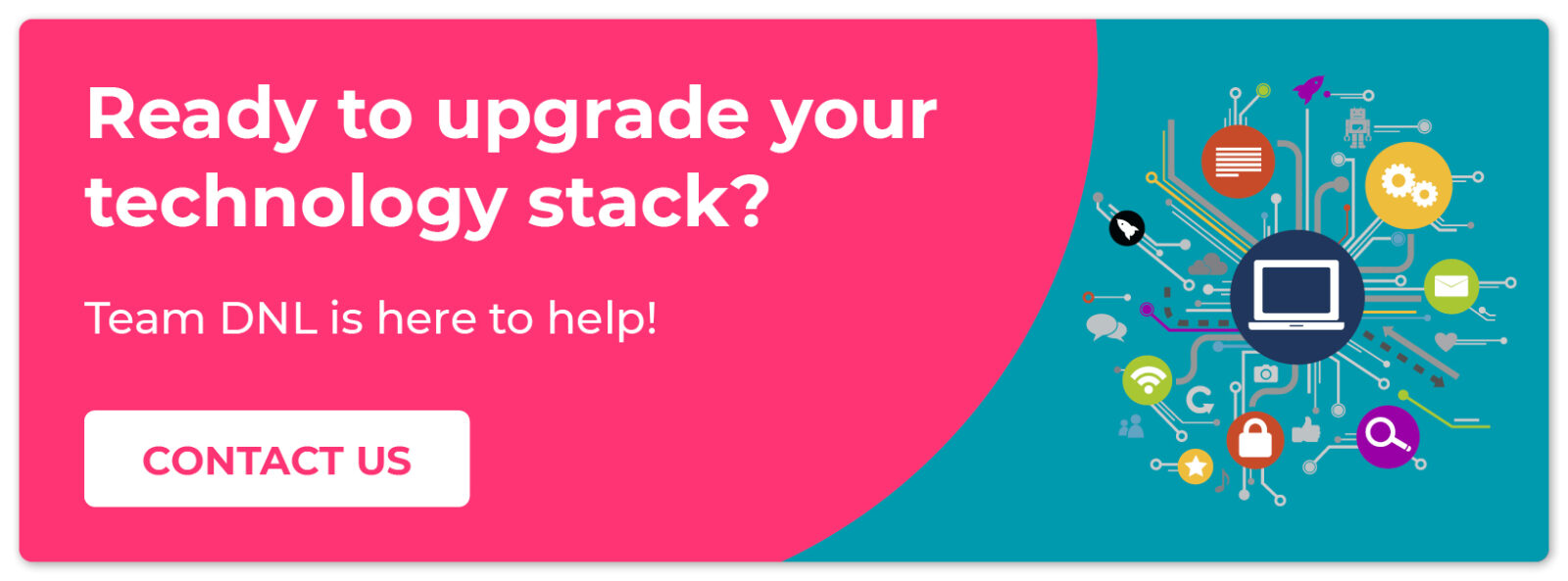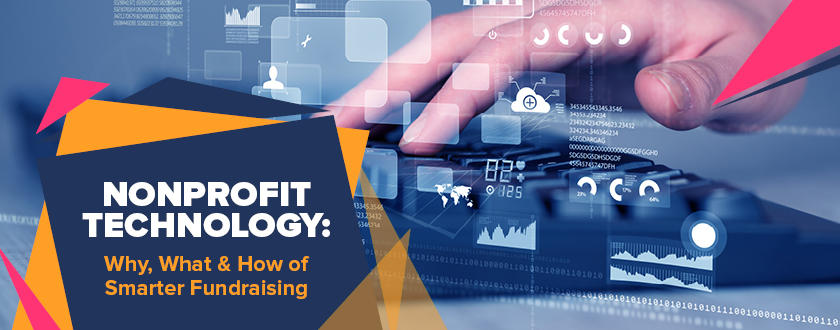Nonprofits have been gradually incorporating technology into their operations for years now and optimizing their internal efforts in the process. From constituent relationship management (CRM) software to giving databases, providers have created solutions meeting a wide range of nonprofit needs.
At DNL OmniMedia, we specialize in helping organizations create the perfect technology infrastructure to meet their needs. We’ve created this guide to assist organizations pivoting to software for the first time and nonprofits revamping their existing technology stacks. Through this guide, you’ll explore the essentials of nonprofit technology:
- Why are nonprofits going digital?
- What technology tools are nonprofits using to improve operations?
- How are nonprofits going digital?
Using nonprofit technology to move your mission forward has become a non-negotiable. Let’s go over everything you need to know to create a sustainable and powerful technology stack for your organization!

Why are nonprofits going digital?
How does technology help nonprofit organizations?
We’ve observed a wide variety of ways that technology improves nonprofit operations. From more efficient donor engagement to increased transparency and oversight, technology has had a positive impact on many aspects of nonprofit work.
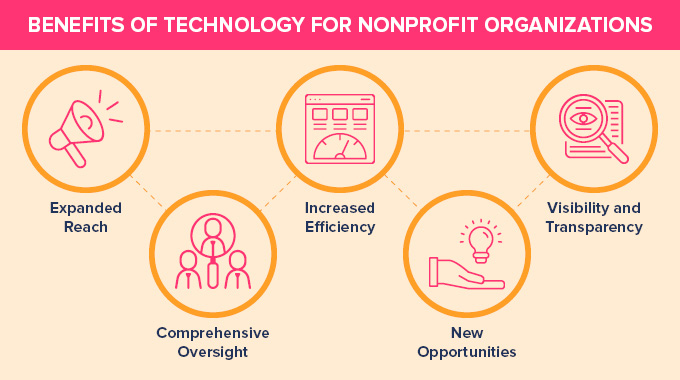
Let’s look at just a few examples of this. Technology helps nonprofit organizations by providing:
- Expanded reach. Technology such as online giving platforms allows nonprofits to drastically expand their reach, accepting gifts from and engaging with supporters near and far.
- Comprehensive oversight. Nonprofit software collects a massive amount of information on donor and internal interactions, and ideally, all of this information flows into one comprehensive CRM. This allows a heightened view of operations.
- Increased efficiency. Many software solutions will integrate with one another, so data flows seamlessly from one solution to the other. This creates a comprehensive dataset that informs all of your tech solutions.
- New opportunities. Technology allows organizations to provide new giving and engagement opportunities to supporters, such as online giving and virtual fundraisers.
- Increased visibility and transparency. Nonprofit tech allows organizations to provide heightened visibility to their supporters, such as sharing videos of the work they’re completing on social media.
These benefits are clear. However, it’s also true that organizations have operated successfully sans technology for years. Why would they invest in technology now?
Why are nonprofits investing in tech solutions?
We know that, generally, nonprofits want to expend the least amount of resources on operations as possible. After all, if you can decrease overhead expenses, you can direct the saved funds toward your cause!
Tech solutions represent an investment in a variety of ways. This includes (but isn’t limited to) licensing fees, consulting, staff training, and ongoing upkeep. Why would organizations looking to decrease overhead costs invest in what potentially costly solutions?
Investments have two parts— a cost now and a benefit in the future. This holds true for nonprofit technology as well! Technology leads to an improvement in operations, and those improvements will allow organizations to steward donors effectively and raise more in the long run. So, while technology is an investment, it’s a worthwhile one.
What are some technology challenges for nonprofits?
Beyond the investment of time and resources, there are also a few challenges that organizations face when implementing nonprofit technology. These include:
- Teams are unfamiliar with new tech solutions.
- Teams feeling resistant to changes in operating procedures.
- Challenging migration, implementation, and integration processes.
- A lack of prioritization with technology, so solutions fall to the wayside before they’re truly impactful.
Later in this piece, you’ll explore tips and tricks to surpass these tech challenges. For now, let’s explore a few key tech tools that can directly improve your nonprofit’s operations. As you’ll see, these challenges are well worth tackling when it comes to the following helpful solutions.
What technology tools are nonprofits using to improve operations?
When it comes to nonprofit technology, there are a wide variety of solutions to meet your organization’s exact needs.
Let’s explore a few popular software solutions that will set your tech stack off to a great start:
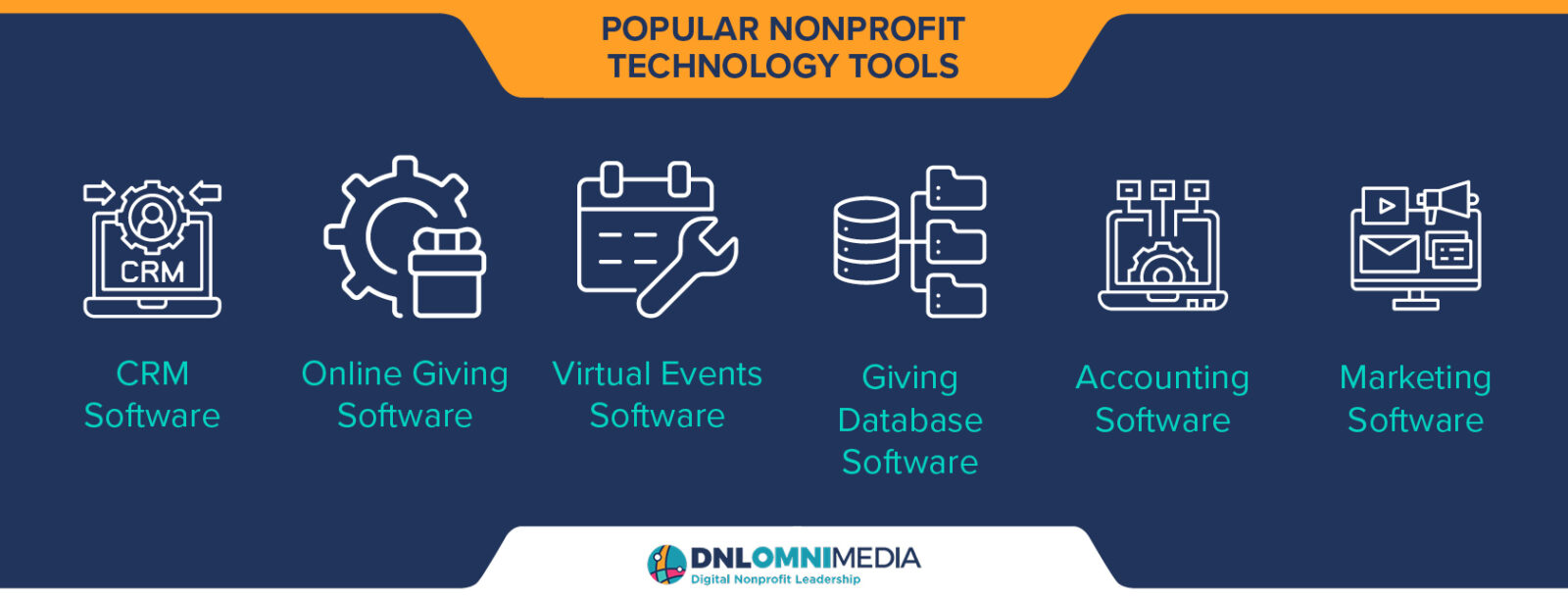
CRM Software
Constituent relationship management (CRM) software functions as a nonprofit’s most comprehensive database. This software collects information on all interactions between nonprofits and their supporters.
Some top providers of CRM software include Blackbaud, Salesforce, and Bloomerang. These solutions range in investment and functionality. For example, robust solutions like Salesforce or Blackbaud will have a longer implementation process and will require some external support. However, they will also have more functionality than a simpler solution!
Key CRM Features
When investing in CRM software, you should look for the following key features:
- Donor management features such as communication tools and relationship tracking.
- Customization capabilities allowing you to mold the software to meet your needs.
- Essential integrations, whether existing or able to be built out.
- Automation features such as automated reporting and follow-up actions.
Want to learn more about some specific CRMs? Check out these guides from Team DNL:
- CRM Software: The Guide to Blackbaud Solutions
- Salesforce Nonprofit Cloud: Complete Rundown for Nonprofits
Online Giving Software
Online giving software is the platform that allows donors to give to your organization through the internet. This is a valuable investment as it allows donors to give regardless of when or where the inspiration hits.
Some examples of online giving software include Soapbox Engage and 99Pledges. Note that these solutions are wide-ranging. For example, Soapbox Engage is a robust giving solution created for Salesforce users, while 99Pledges is a simpler solution for organizations conducting independent pledge fundraising campaigns.
Key Online Giving Software Features
As you research online giving software, here are a few features to keep in mind:
- The ability to accept donations from multiple sources, whether credit/debit card, cash, or direct ACH transfer.
- Mobile accessibility ensures all supporters can give, regardless of the technology used to access the software.
- Customization capabilities that allow you to customize form fields matching the giving options you want to offer and the data you want to collect.
With these features, all donors will be able to give to your cause with ease.
Virtual Events Software
There are many perks of virtual events, including increased accessibility, lowered overhead costs, and engaging new technologies. However, these events can be logistically complicated to host— especially if it’s your first time going virtual.
Luckily, virtual events software manages many of the logistical challenges of holding a virtual event, bringing planning and execution under one umbrella. A few examples of this include OneCause’s virtual auction software, Pathable’s virtual conference software, and Zoom’s video conferencing software.
Key Virtual Events Software Features
When considering software solutions for virtual events, keep the following features in mind:
- Common event management features such as registration, ticketing, and marketing.
- Fundraising capability, ensuring you can raise donations directly within the platform itself.
- Planning and technical support for your team who may be planning a virtual event for the first time.
For a look at virtual events for nonprofits, check out this Team DNL guide to virtual peer-to-peer fundraising.
Giving Database Software
Giving database software takes two main forms: matching gift software and prospect research software.
Matching gift software helps organizations discover corporate philanthropy programs, through which donations to their nonprofit can be doubled, tripled, or more by the donor’s employer. Double the Donation is a top provider of this kind of tool.
On the other hand, prospect research software helps your organization discover which potential donors have the highest giving capacity and affinity. These factors can be strong indicators of which donors are most likely to make major gifts, and a provider such as DonorSearch can help your organization discover and evaluate them.
Key Giving Database Software Features
When it comes to giving databases, here are a few essential features:
- A comprehensive, well-maintained database of donor information.
- Automation capabilities, so the software notifies your organization of match or major gift opportunities when they arise.
- Donor-facing features when applicable, such as allowing a supporter to search their own match eligibility.
Giving database software with these features is a valuable resource to find funding opportunities.
Accounting Software
Nonprofit accounting can be a challenge as there are a variety of rules and regulations that differentiate it from for-profit accounting.
While some organizations may choose to work with an accountant to handle these considerations, accounting software can be just as effective and more cost-efficient. Two top providers of accounting software include QuickBooks and File990, the latter of the two specifically created for nonprofit use.
Key Accounting Software Features
Here are a few essential features for strong accounting software:
- Tracking of tax filing status with automatic reminders, ensuring the organization never loses tax-exempt status due to missed deadlines.
- Ability to file key documents with the IRS directly within the software.
- Customizable user permissions so confidential donor data is only accessible to those who need to review it.
- Ease of navigation and reporting, so even the most accounting-adverse nonprofit professionals can access the information they need to make informed decisions.
Nonprofit accounting can be a stressor for some, but the right accounting software can make it significantly more navigable.
Marketing Software
Regular communication with supporters is key, but it can be difficult to maintain these connections as your donor base grows in size. Marketing software allows you to efficiently share updates, news, and opportunities with supporters on a regular basis.
A few top examples of this include MailChimp’s email marketing software and Blackbaud’s Luminate Online. These solutions range from straightforward email marketing to a full-scale nonprofit fundraising and digital marketing tool.
Key Marketing Software Features
When investing in marketing automation software, keep the following features in mind:
- Automation of communications, whether email newsletters, post-donation receipts, or even social media posts.
- Creation of segments of your donor base to tailor communications by those segments.
- Tracking tools to monitor the success of your communications efforts, reporting on which were most successful and which had little effect.
For more information about marketing automation, check out this blog post regarding making the most of Luminate Online.
How are nonprofits going digital?
As you’ve probably seen by now, technology can dramatically improve nonprofit operations However, this success involves more than just the initial investment in software.
Let’s explore a few best practices that nonprofits have used to make the transition to digital methods as seamless as possible:
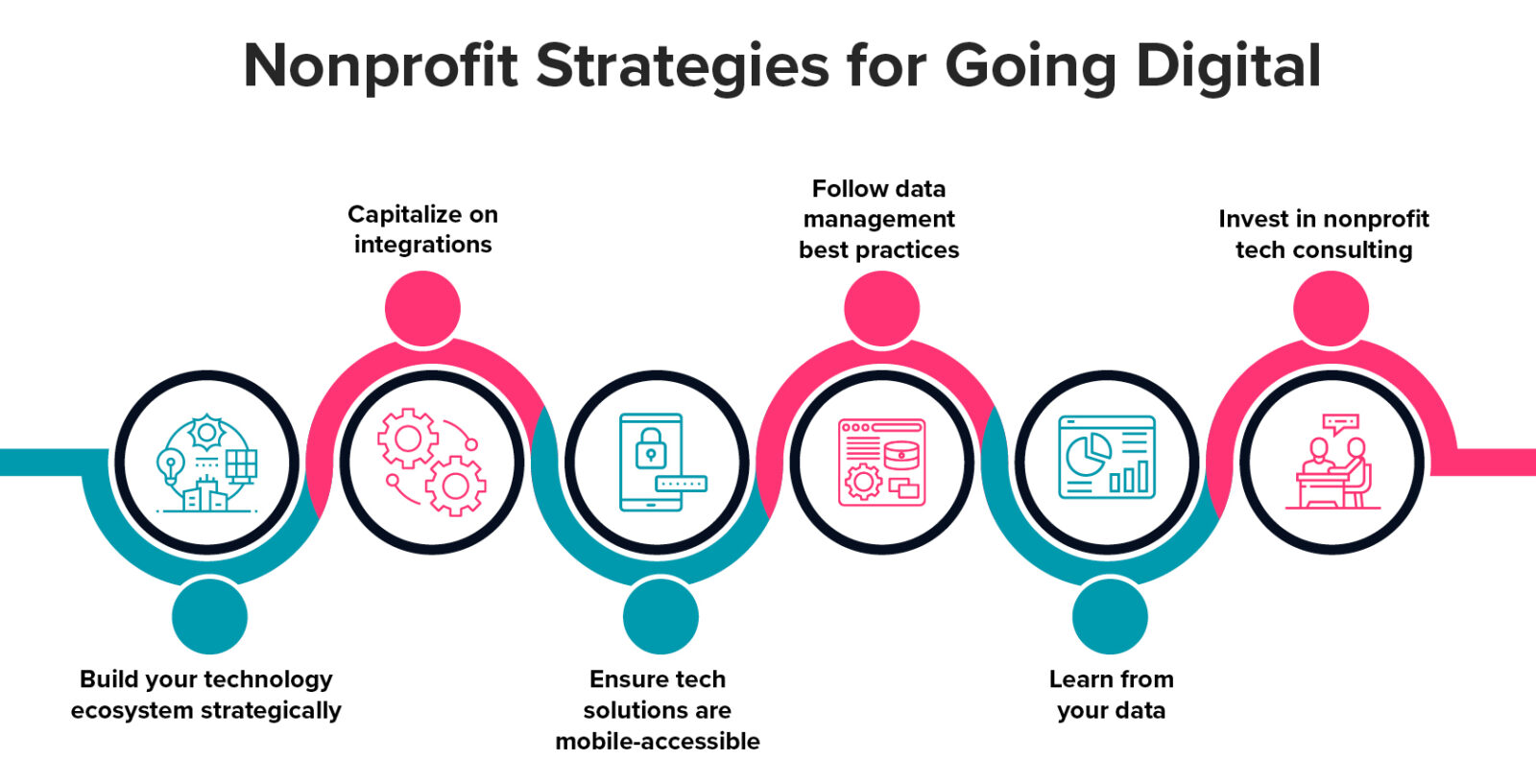
Building their nonprofit technology ecosystem strategically
As you’ve seen, there are a ton of software solutions specifically catered to nonprofits available. However, we know that no two nonprofits are alike. Different causes, different fundraisers, and different supporter bases likely require different technology needs.
Build out your nonprofit’s tech stack with your digital strategy in mind, rather than investing in solutions with little thought to how they’ll function as a unit. When it comes to structuring your tech stack, there are two general routes:
- Investing in a variety of piecemeal solutions. Some organizations prefer to invest in a few different software solutions, each meeting a different need. In this scenario, integrations between solutions are essential.
- Investing in more robust solutions. Organizations with more intensive software needs may choose to invest in one robust solution, such as those provided by Blackbaud and Salesforce. This is a larger investment and often involves customization to meet the nonprofit’s exact needs.
Capitalizing on nonprofit technology integrations
Part of building a strategic technology ecosystem is making the most of software integrations, especially if you choose a more piecemeal solution.
Software integrations are seamless connections built between two solutions, allowing information to flow from one platform to the other with little effort on your end. No more manual data transfer!
The most essential connections to build are those between your CRM and your various software solutions. Because your CRM represents the most comprehensive collection of your nonprofit’s data, the information within it should be kept up-to-date with the data collected from your other solutions.
CRM integrations allow data from your software solutions to flow freely into your database. Further, these connections allow your CRM data to inform the actions of your other solutions— for example, directly importing contact information into your email marketing software.
While these connections are essential and you should capitalize on them, that doesn’t mean that they’re simple to create. The integration process can be complicated, so it’s often a good idea to work with a nonprofit technology consultant to manage the process.
Ensuring their nonprofit tech solutions are mobile-accessible
Mobile internet use is on the rise, with over 92% of internet users accessing the internet with their smartphones. Further, 15% of U.S. adults report being smartphone-only internet users— as in, the only method they’re accessing the internet through is their mobile phone.
These statistics mean one thing: If your donor-facing solutions aren’t mobile-accessible, then you’re deterring (or even excluding) a segment of your population from interacting with them.
This includes your:
- Website
- Donation Pages
- Event Pages or Registration Tools
- Advocacy Solutions
Mobile accessibility means each of these solutions should be just as functional and intuitive on mobile devices (smartphones, tablets, etc.) as they are on desktop devices.
Following nonprofit data management best practices
One of the many perks of incorporating technology into nonprofit operations is the ease with which you can collect data. However, this also means that you’re going to be collecting, storing, and analyzing more than ever before. If you don’t have procedures in place to do so efficiently, your CRM can quickly grow out of hand.
When it comes to data management, here are a few best practices:
- Understand which data to collect. You should only collect the data you plan to use, rather than superfluous information on each and every interaction. There are ways to pare down the data you’re collecting, such as only asking donors to provide the exact information you prepare to utilize.
- Create consistent data hygiene procedures. Creating procedures for the standardized entry of data and handling of errors is essential to ensure your CRM isn’t filled with unhelpful information.
- Improve your data management practices with third-party help. Data management can be tedious, challenging, and precise— partnering with a firm that specializes in data solutions can be a time and headache-saver for your team.
Learning from the data collected by nonprofit tech
Of course, you’re not collecting the data mentioned in the last section for it to simply take up space in your database. Instead, use the data you’re storing to improve your efforts going forward.
Begin by segmenting your data, which involves organizing data points into groupings by similar characteristics. Examine these segments to discover trends in your donor base, such as:
- Favored giving methods or fundraiser types. For example, you might find that certain giving tenders (ex: card, check, etc.) are favored over others or certain fundraiser types (ex: peer-to-peer) regularly have the highest engagement.
- Preferred communication methods and frequency. You may discover that certain outlets of communication are receiving little response, while others have high response rates. You may even find that supporters desire a higher/lower communication frequency.
- Decreasing engagement within segments. You may discover segments of your donor base that are engaging less and less with your organization’s fundraising efforts, volunteer opportunities, and more. From there, you can prioritize donor retention efforts targeting those segments at risk of attrition.
These are just a few examples of insights to look for in your database. When you discover these trends, you can optimize your efforts in response— whether incorporating popular fundraising methods, relying on new methods of communication, or reaching out to donors at risk of lapsing their support.
Investing in nonprofit technology consulting
Whether your organization is investing in nonprofit technology for the first time or looking to upgrade your current tech stack, there’s no denying that the transition can be a challenge for nonprofit professionals.
Consider investing in nonprofit technology consulting to ensure the process is a smooth one. These consultants can:
- Develop a comprehensive digital strategy to reach your goals with technology.
- Discover the ideal software solutions to meet your organization’s needs.
- Manage the migration to and implementation of new tech solutions.
- Train staff members to make the most of your software.
Explore Team DNL’s guide to nonprofit technology consulting to determine whether this type of assistance would benefit your organization’s efforts.
While consulting is essential for robust nonprofit solutions such as those provided by Blackbaud and Salesforce, it can also be beneficial for organizations investing in a variety of independent solutions.
Nonprofit technology can have a drastic impact on your organization’s operations going forward, especially if you approach building your tech infrastructure strategically.
For more nonprofit tech information, explore the following additional resources:
- Creating a Nonprofit Digital Strategy: 7 Steps for Success. Explore this guide to creating a strategy to reach your goals using technology.
- Blackbaud vs. Salesforce: A Full Comparison for Nonprofits. In this guide, find a comparison of two top nonprofit software providers, Blackbaud and Salesforce.
- Salesforce for Nonprofits Implementation: What to Expect. Read more about the implementation process involved with one of the most robust nonprofit technology solutions.
